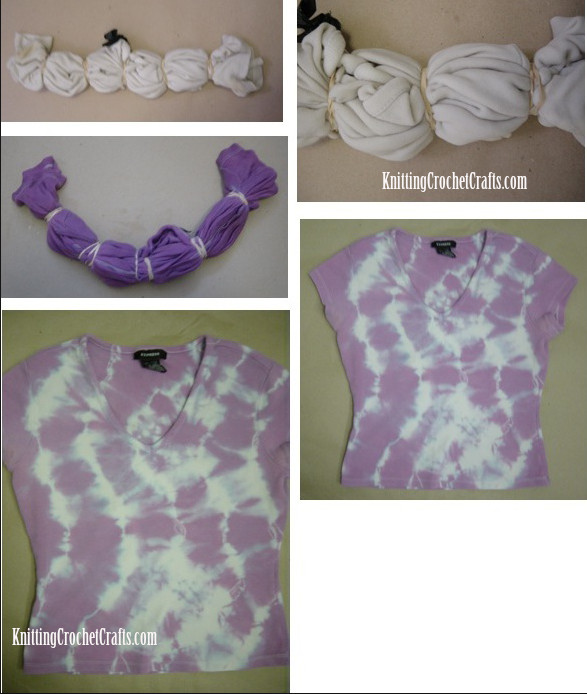Tie Dye Can Be a Really Sustainable Craft Technique If You Use It To Revive Stained or Dingy-Looking Garments to Prolong Their Wearability.

I love white T-shirts. They’re cool and comfortable. They match everything. The downside? They get stained and dingy-looking after awhile. When a T-shirt reaches that point, it’s tempting to toss it out and get a new one. After all, T-shirts aren’t exactly expensive.
The problem with that line of thinking is that it isn’t sustainable. There’s no need to send a stained T-shirt to the landfill, when you can give it a dyebath and a whole new life.
The photos I’ve posted with this article show a shirt that I saved from the trash. It used to be a white cotton/spandex blend T-shirt. I wore it for a few years. It eventually got so stained that I was embarrassed to wear it in public. Rather than trashing it, I decided to see if tie-dyeing it would cover the stains.
The Tie-Dye Process:
I loosely folded the shirt making several horizontal pleats, and then secured it with rubber bands. You can take a look at the photo to get a better idea of how it looked, both folded and after dyeing. That kind of fold produced an undulating vertical striped pattern. To get the effect shown in the photo, I applied a single color of dye in a pretty purplish-pink color.
I was amazed at how well the dye covered up the stains. It was almost like having a new shirt.
Tips for Over-Dyeing Previously-Worn T-Shirts and Other Clothes:
There are some stains that are going to be easy to cover, and some that will take some real creativity to incorporate into a tie-dyed design. Even if you can’t completely cover a stain, at least the stain won’t be as obvious on a tie-dyed shirt as it will be on a plain white shirt. The colorful tie-dyed design will distract from the stain.
Fibers to Dye:
Overdyeing works best with cotton or other natural-fiber shirts, assuming that you are using dyes that are readily available to the public. I recommend using fiber reactive dyes to dye cotton garments. The easiest thing to do is to purchase a tie dye kit. However, you can also buy dyes and the other supplies you need separately.
Synthetic fibers such as polyester and acrylic are not easy to dye at home, and I wouldn’t recommend trying.
It is possible to dye a poly-cotton blend using dyes intended for cotton fabric. Success is not guaranteed, but you could get lucky. Generally speaking, the cotton will dye nicely but the poly will not. If you were to immerse a cotton shirt and a poly-cotton shirt in the same dyebath, the poly-cotton shirt would end up looking lighter in color than the cotton one. If the poly-cotton fabric is blended well, you probably wouldn’t notice that the poly remains un-dyed; if you were to inspect the fabric very closely you would probably be able to tell, though.
When dyeing poly-cotton blends, it is possible that you could run into a problem known as ‘barre,” (pronounced “bar-RAY,”) where the dye highlights some inconsistencies in the fiber of the shirt. That’s a risk you take when you dye a blended poly-cotton fabric.
Overdyeing Colors:
Keep in mind, also, that you do not have to start with a white T-shirt. You can try over-dyeing a T-shirt of almost any color. It might or might not work, depending on a variety of factors, but in my experience you will achieve more successes than failures.
If you are dyeing a colored T-shirt, choose a dye that is darker than the color you are going to dye over. For example, if you are going to dye overtop of a blue T-shirt, you could use a darker blue dye in combination with tie-dye techniques to produce a tonal tie-dyed effect.
Pitfalls to Beware of When Upcycling Clothes Using Tie Dye Techniques:
The upcycling process doesn’t always go smoothly; there are pitfalls to beware of. The pitfall I’ve run into most is the “White poly thread” dilemma. You’ll sometimes find that a garment can be dyed successfully, but the thread doesn’t take dye. For example, this can happen when polyester thread was used to sew a cotton garment. If you use a very dark dye overtop of a T-shirt that was originally a very light color, the un-dyed poly seams might become much more obvious than they were to start with. If you find yourself in that situation, you can color the seams with a fabric marker. That isn’t a quick process, but it works.
Overdyeing Prints:
I’ve also achieved some interesting results with overdyeing printed garments. On several occasions, I’ve given thrift-store purchases a color makeover with that technique. Some of the transformations have been pretty amazing. You can take a garment in an outdated color scheme and dye overtop of it. If you choose colors wisely, it could end up looking brand new.
Learn More About Tie-Dye:
If you’d like some more in-depth tutorials on the topic of tie dye, please take a look at the following pages:
- Product Review of Jacquard Tie Dye Kits
- How to Tie-Dye a Spiral or Swirl
- How to Tie-Dye a Heart Shape
- How to Tie-Dye a Striped T-shirt
- Tie Dye: A Case Study of What Not to Do
I hope these tips have given you some insights and ideas for recycling your own stained / outdated T-shirts and garments with dye. Happy (green) crafting!
Posted By: Amy Solovay
This page was last updated on 5-25-2023.